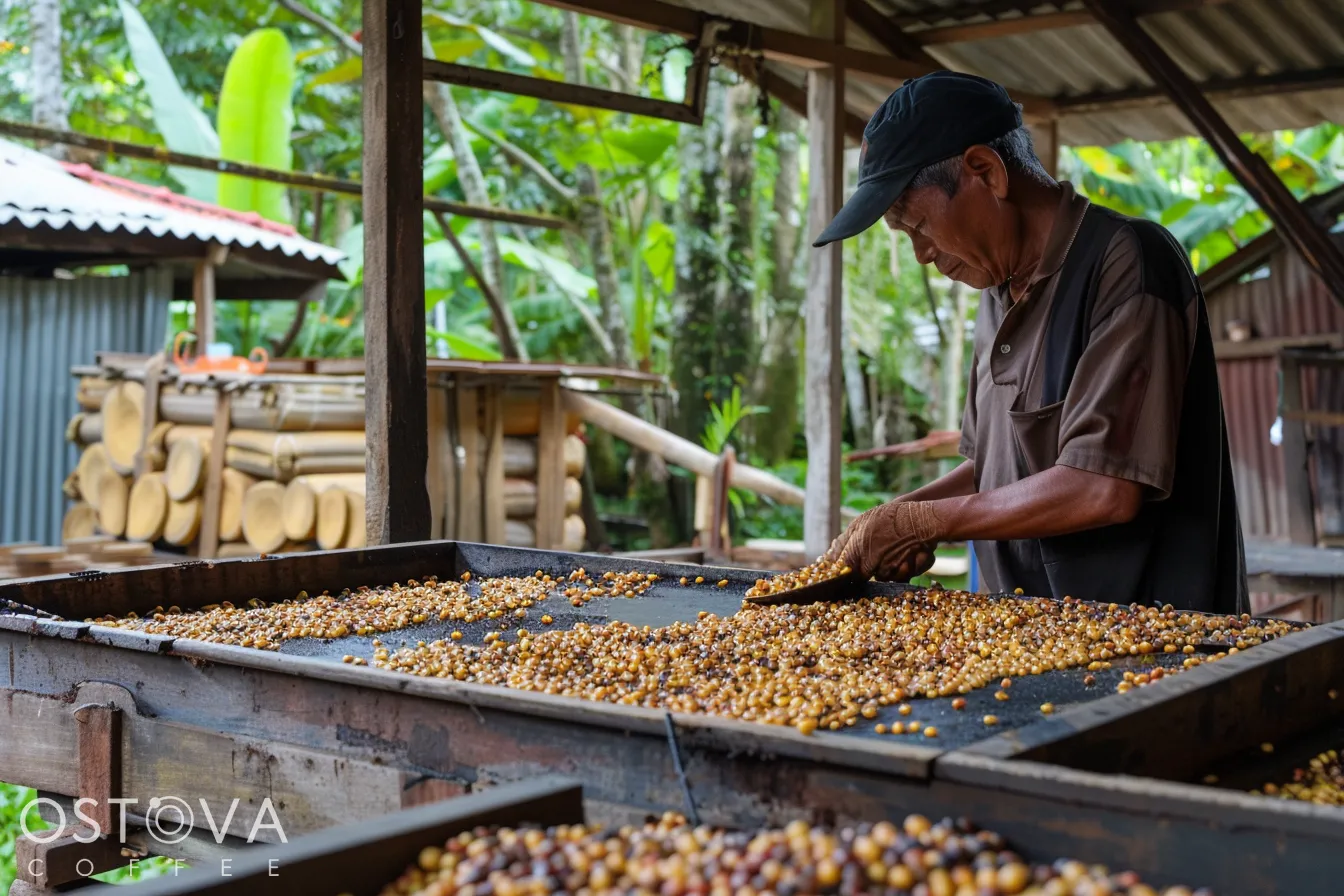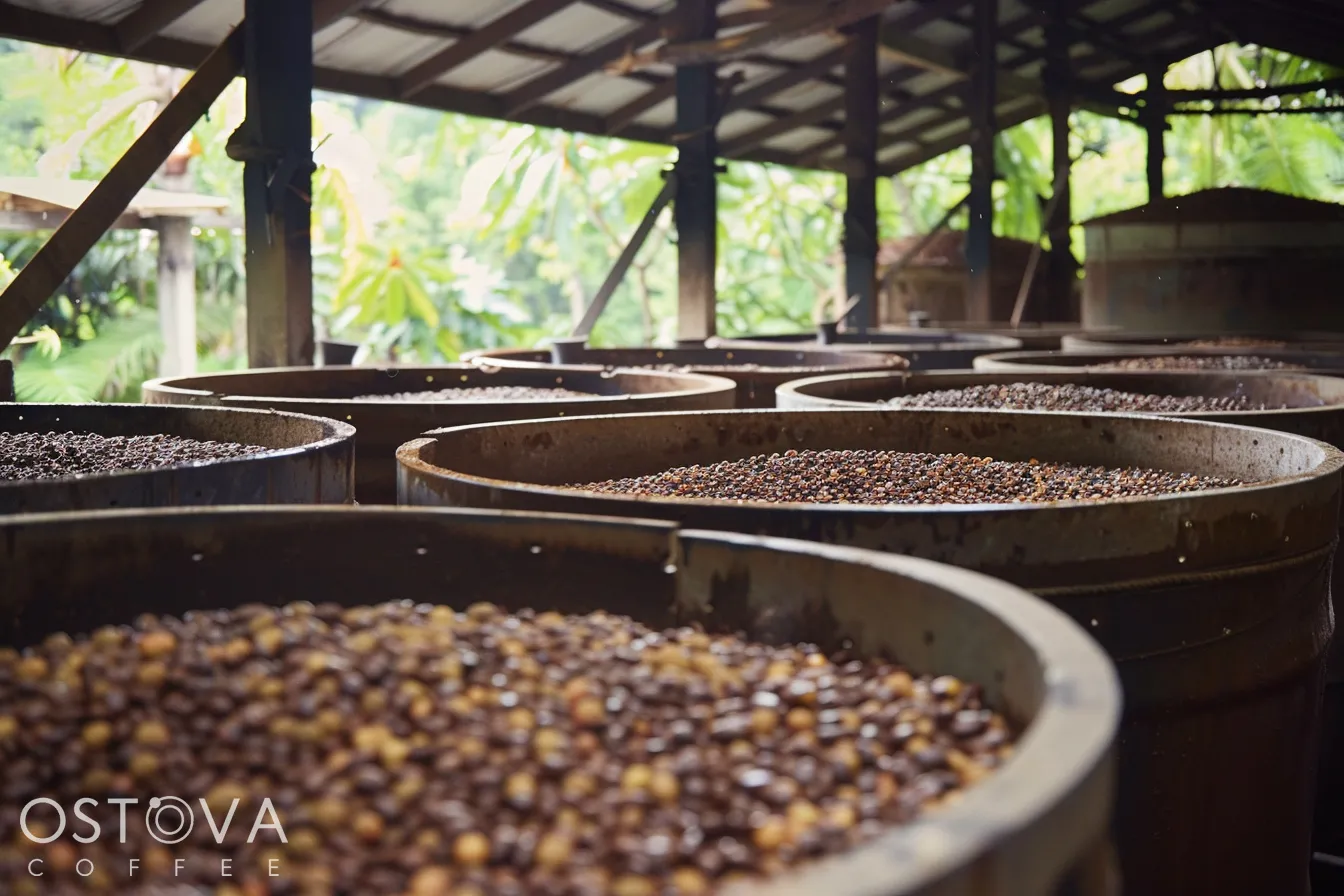Indonesia Coffee Processing
Ever wondered why that cup of coffee from Ostova Coffee tastes so uniquely rich and complex? The secret lies in the fascinating and intricate coffee processing methods used in Indonesia. From the volcanic slopes of Sumatra to the lush highlands of Sulawesi, Indonesian coffee is celebrated for its distinct flavor profiles, thanks to a unique method known as wet-hulling, or Giling Basah. This process gives the coffee a heavy body, low acidity, and those unmistakable rustic, earthy flavors that coffee lovers can’t get enough of. But that’s not the whole story. At Ostova Coffee, we collaborate with local cooperatives to bring you a variety of experiences—from traditional, deep, complex brews to clean, bright coffees with delightful fruity notes.
Steps of the Wet-Hulled Process
Harvesting: Cherry Merah
The journey starts with small-holder farmers, who handpick perfectly ripe cherries, known locally as Cherry Merah. These cherries are then sold to local collectors. The coffee market in Indonesia is highly competitive, with prices fluctuating daily. To stay ahead, farmers use mobile communication platforms like WhatsApp for real-time pricing updates and quick transactions.

Honoring Tradition: Time-Tested Coffee Processing Techniques
Depulping: From Cherry to Bean
Once the cherries are collected, they are depulped using either hand-cranked depulpers or more centralized machines. In regions like North Sumatra and Aceh, floating the coffee to separate high-quality beans from the rest is a common practice.
Depulping: Transforming Cherries into wet parchment coffee
Fermentation and Drying: Gabah Basah and Labu
Next, the depulped coffee undergoes fermentation for 8-18 hours. This step breaks down sugars and mucilage, resulting in wet parchment coffee, known as Gabah Basah. The Gabah Basah is then partially dried to reduce its moisture content. This semi-dried coffee, now referred to as Labu, is sold to cooperatives, millers, or exporters.

Fermentation and Drying: Crafting Gabah Basah and Labu
Wet-Hulling: The Signature Step
In the wet-hulling stage, the parchment is removed using friction from rubber paddles while the coffee still retains a moisture content of 40-45%. This step is unique to Indonesia and is crucial for creating the coffee’s distinctive flavor profile. After wet-hulling, the coffee, now called Asalan, is dried on patios or tarps to reach a moisture content of 18-25%.
Cleaning and Final Drying: Ready for Export
The Asalan coffee is then cleaned and further dried to achieve a moisture level of 13%, making it ready for export. Depending on the level of sorting, it is sold as Double Picked (DP) or Triple Picked (TP), ensuring a higher quality product.
The Why: Speed and Adaptation to Climate
Why does Indonesia use the wet-hulled process? It’s all about efficiency and adaptability. Coffee is a vital cash crop for many Indonesian farmers, and faster processing means quicker financial returns. Additionally, Indonesia’s tropical climate, characterized by high rainfall and humidity, makes traditional drying methods impractical. By removing the parchment early, the coffee can dry more quickly and effectively, even in unpredictable weather conditions.
The Impact: Flavor and Beyond
The wet-hulled process not only speeds up production but also deeply influences the flavor profile of Indonesian coffee. The friction-based removal of parchment at high moisture levels adds to the heavy body and earthy flavors characteristic of Sumatran and Sulawesi coffees. These unique flavors have made Indonesian coffee a favorite among those seeking bold, distinctive brews.
Indonesian coffee processing is a testament to the ingenuity and resilience of its coffee farmers. The wet-hulled method, with its distinct steps and outcomes, defines the flavor profiles that make Indonesian coffee stand out in the global market. At Ostova Coffee, we’re proud to bring you the best of these unique brews, whether you’re savoring the deep, earthy notes of a Sumatran coffee or the bright, fruity tones of a Sulawesi cup.
By understanding the what, how, and why of Indonesian coffee processing, we gain a deeper appreciation for every cup. It’s not just about the flavor; it’s about the journey from cherry to bean and the hands that guide it along the way. Enjoy your next cup from Ostova Coffee, knowing it’s crafted with care, tradition, and a touch of Indonesian magic.
